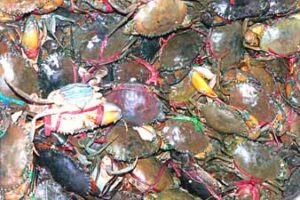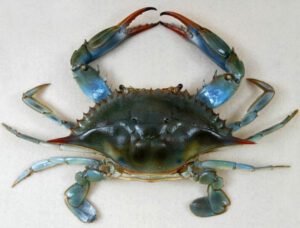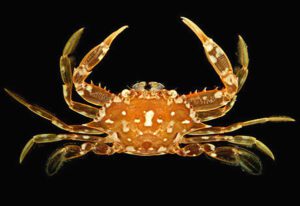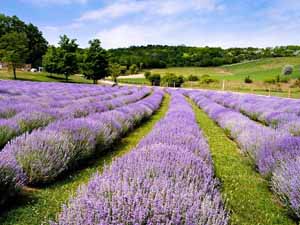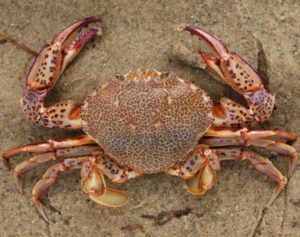The Dungeness crab is a species of crab that inhabits eelgrass beds and water bottoms on the west coast of North America.
It is named after Dungeness, Washington which is located approximately 8 km north of Sequim and 24 km east of Port Angeles.
Usual range of these crabs extends from Alaska’s Aleutian Islands to Point Conception, near Santa Barbara, California.
It is occasionally also found as far south as Magdalena Bay, Baja California Sur, Mexico.
This crabs have recently been found in the Atlantic Ocean, far from their known range, raising concern about their possible effects on the local wildlife.
Some Dungeness crabs can also be found as far east as Florida, North and South Carolina and Alabama. Read some more information about this crab species below.
Dungeness Crab Characteristics
The Dungeness crabs have a wide, long, hard shell, which they must periodically molt to grow (this process is called ecdysis). They have 5 pairs of legs.
And their legs are similarly armoured (the foremost pair of which ends in claws the crab uses both as defense and to tear apart large food items). They have short eyestalks with small orbits.
Common color of the Dungeness crab is beige to light brown with blue trim, often light orange below. Fingers of chelipeds are without dark color.
Average carapace length of these crabs is around 20 cm, and may reach 25 cm in some areas off the coast of Washington. Photo and info from Wikipedia.
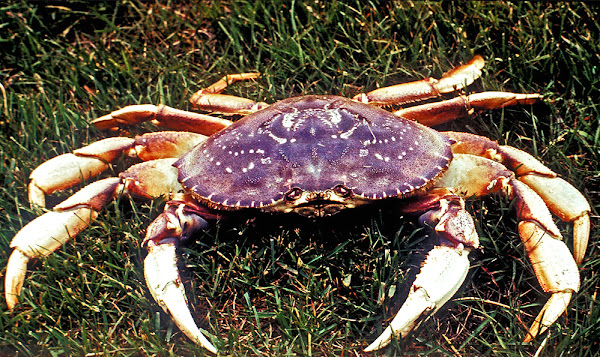
Breeding
The female Dungeness crabs reach maturity at around 10 cm carapace width. Hatching generally occur from mid-December through late January in California.
The larvae are distributed in the estuarine waters. Maximum hatching occurs at a salinity of about 15 ppt. Optimal temperature for larval crabs is between 10 and 14 °C.
Uses
The Dungeness crabs are mainly used for food. They are very popular as food in many countries.
They are available for direct human consumption in a wide range of product forms.
Special Notes
The Dungeness crab is a popular seafood and it is highly prized for it’s sweet and tender flesh.
It is a popular delicacy and is the most commercially important crab in the Pacific Northwest, as well as the western states generally.
It is highly prized by both commercial and sport fisherman. These crabs are mainly captured with baited pots, nets, hooks and lines and also by hand.
The Dungeness crabs are generally found on soft bottoms in very low intertidal areas to a depth of about 360 meters.
The juveniles inhabit and forage on estuaries, especially in oyster reefs, oyster beds and eelgrass.
The Dungeness crab is very popular as food. About one quarter of the crab’s weight is meat.
The flesh of this crab has what is considered to be a delicate flavor and slightly sweet taste. It is a long lived crab species with a maximum recorded lifespan of 10 years.
However, review full breed profile of the Dungeness crab in the following table.
| Name | Dungeness Crab |
| Kingdom | Animalia |
| Phylum | Arthropoda |
| Class | Malacostraca |
| Order | Decapoda |
| Family | Cancridae |
| Genus | Metacarcinus |
| Species | M. magister |
| Binomial Name | Metacarcinus magister |
| Other Names | Also known as Cancer magister |
| Breed Purpose | Food |
| Special Notes | Popular seafood, highly popular for it’s sweet and tender flesh, is a popular delicacy and is the most commercially important crab in the Pacific Northwest, highly prized by both commercial and sport fisherman, generally found on soft bottoms, very popular as food, maximum recorded lifespan is 10 years |
| Breeding Method | Natural |
| Climate Tolerance | Native climate |
| Body Color | Beige to light brown with blue trim, often light orange below |
| Rarity | Common |
| Availability | America |

